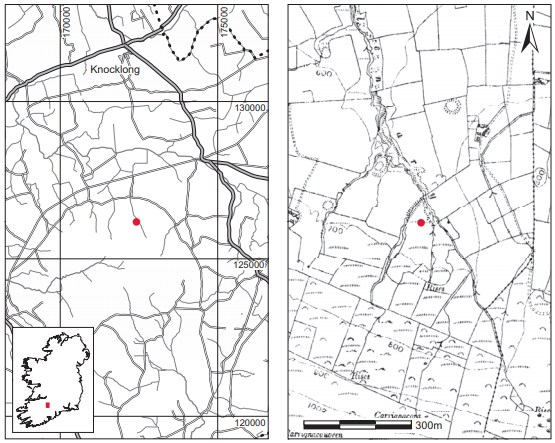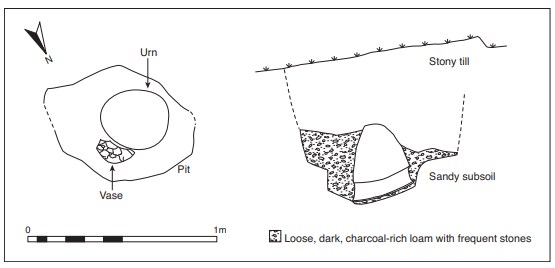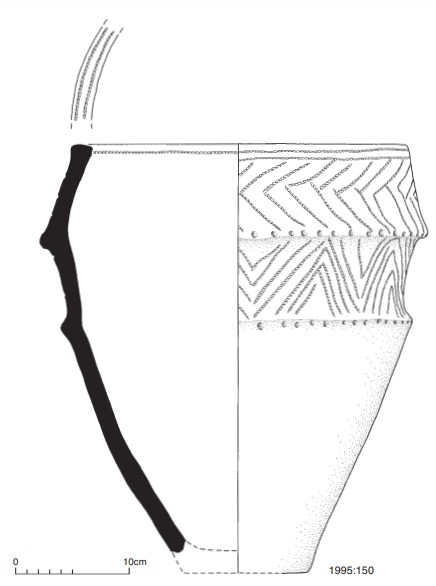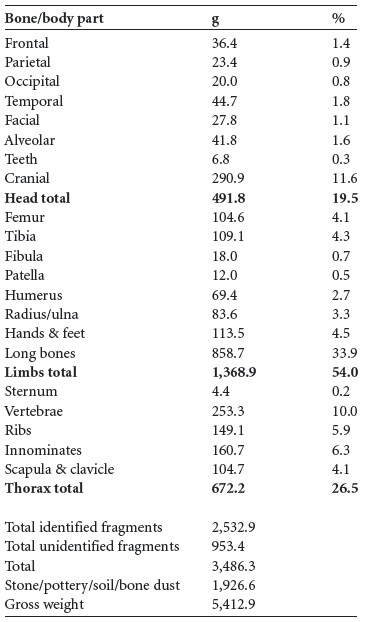County: Limerick Site name: GLENLARY, CO. LIMERICK
Sites and Monuments Record No.: SMR LI049-271SMR LI-049-095SMR LI049-093SMR LI048-081 Licence number: E1111
Author: ANDREW HALPIN AND ANNA L. BRINDLEY
Site type: Early Bronze Age graves
Period/Dating: —
ITM: E 572385m, N 626234m
Latitude, Longitude (decimal degrees): 52.386955, -8.405668
Introduction (AH)
In June 1995 a pit burial containing a cremation within an urn and sherds of two other vessels was discovered on a farm near Galbally, Co. Limerick. The burial was in a pocket of sandy soil, which had apparently been dug out by previous farmers. The digging left an almost vertical face, approximately 0.6m high at its southern limit, which had been further eroded by the regular passage of cattle. The base of the inverted urn is therefore likely to have been exposed and broken by cattle.

The farmer, Mr David Shanahan, reported the find to the Garda Síochána at Ballylanders, who informed the NMI. The site was investigated by Andrew Halpin. The human remains were examined by Barra Ó Donnabháin.
Location (Fig. 3.100)
The site was in the townland of Glenlary, south-east Co. Limerick.165 It was at an altitude of 200m above sea level near the head of the valley of the Glenlary River, a small stream flowing northwards off the slope of Slievereagh (473m), and in a triangular tongue of land at the confluence of the Glenlary River and a smaller tributary. The site is overlooked by Slievereagh to the south and by higher ground to the east and west. Near the summit of Slievereagh, less than 1km to the south, are a stone circle,166 a megalithic structure167 considered unclassifiable by de Valera and Ó Nualláin (1982, 79) and a possible cemetery cairn.168 The site is c. 2.5km east of Cush, where Ó Ríordáin excavated a number of urn burials (Ó Ríordáin 1940), and c. 3km south-west of the extensive ring-barrow cemeteries of the Mitchelstowndown area, which are regarded as middle Bronze Age in date (Daly and Grogan 1993). Another urn burial in a barrow was excavated by Ó Ríordáin at Lissard, c. 6km to the north-east (Ó Ríordáin 1936), while at Knockadea, c. 9km to the south, a large cordoned urn was found along with two smaller vessels of uncertain form, apparently in a cist (Power 1931, 55–6).
Description of site
The base of the pit lay 0.77m below ground level (Pl. 36). The vessels were contained within a small, subcircular pit dug into the sandy subsoil. The pit was only slightly larger than the urn at the base but was wider at the top. It measured 0.46m wide at the base and survived to a height of 0.38m (Fig. 3.101).169
The pit contained three vessels—an inverted collared urn, a smaller vessel and one sherd of a third vessel—and a cremation (1995:153). The cremation was contained within the collared urn and the smaller vessel had been placed next to it. The latter had been badly crushed, and the sherds were found at the base of the pit. A flint blade (1995:152) and a single sherd (1995:151.2) of another urn were also found. The pit was filled with a loose, dark, charcoal-rich loam with frequent small stones. The top of the pit was sealed by a spread of this fill, extending beyond the limits of the pit. This, in turn, and the sandy subsoil into which the pit was cut were sealed by a more compact, stony till. The cremation deposit within the urn was apparently undisturbed, and was lifted intact within the urn and subsequently excavated in the Museum laboratory.


Pottery (Pl. 37) (ALB)
Collared urn, 1995:150 (Fig. 3.102)
This vessel is in good condition. The base had been damaged at the time of discovery and was subsequently conserved. About two thirds of the base and its immediate side wall were affected. Otherwise the vessel is complete. The upper zone/collar slopes in to the rim at a gentle angle, the middle zone/neck is vertical and the lower zone/body slopes with a slightly sinuous line in to the base. The rim is flat-topped with a small inside spur. The collar is well marked but not pronounced with a small overhang, and there is a well-marked cordon just above mid-height. The collar and cordon emphasise the angled profile; these angles are also well marked on the inside of the vessel.
The paste is light grey/beige/orange in colour, with a wide black core. The fabric is densely gritted with large and medium angular stone inclusions. These are visible on the surface and have fallen out in places. The surface is fairly regularly smoothed down and has been finished with a soft or flexible implement or by hand, as is shown by some smearing of the surface. The outer surface shows some crazing. Inside the vessel there is a series of well-marked stained zones and there is some sooting and charred matter adhering to the wall. The lowest part of the interior is blackened, with a whitish/grey band above this, followed by a wide band of brown staining. The upper part has sooting and charred matter. There are also vertical stain marks, suggesting that condensation had run down the inside of the vessel wall at some stage.
Ornament is executed in twisted cord impressions and oval impressions and is confined to the upper two zones, the top of the rim and, unusually, also the inside edge of the spur and the tops of the collar and cordons. The oval impressions occur on the collar and cordon tops. Concentric impressed cord lines occur on the inside edge of the spur (one line), the top of therim (two lines) and immediately below the rim (two lines). The upper zone is filled with a wide chevron band; the lower zone is filled with a zigzag of nested triangles, except at the point where the zigzag fails to meet up and the pattern is bridged by a small panel of horizontal lines. The oval impressions are somewhat irregular. Although they are fairly similar to fingertip impressions, there is no trace of a nail impression. The vessel is well made, neatly finished and decorated. Although typical of its type, it is distinguished by a number of uncommon or unique elements. The ornament on the rim is concentric simple lines rather than the more usual radial or zigzag. The oval impressions on the collar and cordon are also uncommon. Edmondstown, Co. Dublin (Kavanagh 1976, no. 34), and Tara, Co. Meath (ibid., no. 37), are other examples. The form of zigzag with nested triangles is also rare (Bonecastle, Co. Down: ibid., no. 27). Zigzag ornament combining hatched rather than nested triangles is very common. Even the broad band of chevron is unusual, although it does occur in incised form on a collared urn from Tara, Co. Meath (ibid., no. 38), and as cord-impressed on a cordoned urn from Gorteen, Co. Louth (ibid., no. 33). The comparatively unaccentuated collar, the use of cord impression and the absence of incised decoration on the lower half of the vessel suggest that this collared urn is not especially early in the series. These aspects point in the direction of the cordoned urn tradition.
Dimensions: H 38.5cm; ext. D rim 29cm; D base 12cm; D collar 34cm.
Anomalous vase, 1995:151.1 (Fig. 3.103)
This vessel has been partly reassembled from sherds. A small part of the basal angle appears to be missing. The sherds are friable, and crumbs and surface fragments have become detached in places. The vessel is not especially well made. It is markedly asymmetrical, having slumped during its manufacture. It has a flat rim and a short ‘collar’, which narrows abruptly before swinging out to a rounded shoulder. The paste is chiefly beige in colour, with mottled bluish/grey staining on parts of the inside body. This may be post-firing staining or could be due to contact with hot material. The core is wide and black. The vessel is coil-built and has split at mid-belly and along the shoulder. The fabric is densely gritted with angular, mediumsized, chiefly dark-coloured stone. The inside of the vessel has been only roughly finished; it does not appear to have been fully smoothed or polished, except possibly at the base. The exterior has been smoothed, probably by hand or with a soft and flexible tool, smoothing down most of the temper. Some inclusions have fallen out. The surface is crazed (the extent of this is masked by breaks and crumbling of the surface). The decoration occurs on the rim top, the neck and the neck and shoulder. It is carelessly incised. The rim top bears oblique,

radial lines; the upper neck bears a zigzag band or horizontal hatched and obliquely hatched standing triangles; a hurdle pattern fills the area between this and the shoulder.
This vessel has no close parallel. Its general appearance, chiefly its decoration, suggests a diminutive collared urn, despite the fact that the ‘collar’ does not overhang and the shoulder lacks a cordon. Collared urns are rarely accompanied by accessory vessels, but those that do occur tend to be anomalous in type. In fact, the closest comparable vessel is a small vessel that accompanied a cordoned urn from Knockadea, Co. Limerick (Ó Ríordáin and Waddell 1993, no. 633). Although there are few direct similarities between the two vessels, both share a strong general similarity to collared urns. The Knockadea vessel has a much longer collar and a short neck, and its incised decoration is erratically arranged and covers the whole of the exterior of the vessel.
Dimensions: H 11–12.5cm; the mouth is not quite regular, with D ranging from 12cm to
13cm; D base 6cm; T wall 0.8cm.
Urn (cordoned?), 1995:151.2 (Fig. 3.103)
In addition to these two vessels, a single sherd of the cordon of another urn was found. The temper does not appear to be as dense as that of the collared urn and there is no distinct core, the beige colour extending across the full width of the sherd. The absence of an inside angle behind the cordon and the apparent absence of decoration in the vicinity of the cordon suggest that this sherd may be derived from a cordoned urn.
Flint blade or knife, 1995:152 (Fig. 3.103)
The object was broken in three parts, probably as a result of cremation, and has been reconstructed. Oblong blade of roughly plano-convex section, considerably narrower at one end than at the other; bifacial retouch along both edges.
Dimensions: L 7.11cm; W 2.24cm; T 1.42cm.
Comment (AH)
The Glenlary pottery consists of a cord-decorated collared urn, an anomalous vase with collared urn attributes and a sherd of a second urn, possibly of cordoned urn type. This pottery belongs to the middle stage of the early Bronze Age. A sample of the human remains was submitted for AMS dating and yielded a date of 3470±40 BP, which calibrates to 1891–1689 BC at 95% probability.170 Brindley (2007, 285) places the collared urn in stage 2 of the developmental sequence of the collared urn typology, which is dated to 1800–1700 BC. Brindley (2007, 262–4) also suggests that the vase with its collared urn appearance may date from c. 1700 BC and that it ‘represents the last influences of the vase tradition within the milieu of the collared urn tradition’.
HUMAN REMAINS
BARRA Ó DONNABHÁIN’
Introduction
A large deposit (1995:153), weighing 5,412.9g and comprised mostly of fragments of calcined bone, was submitted for analysis. The collection also contained small pebbles, small fragments of prehistoric pottery (presumably from the urn), charcoal, soil and bone dust. It was possible to separate most of the bone, though fragments of just a few millimetres in length were left with the bone dust/soil/pebble mix. Once the latter was excluded, the remaining deposit of burnt bone amounted to 3,486.3g and contained about 4,000 fragments. Each of these was examined and identifiable portions of bone were sorted according to the body part from which they were derived. It was possible to identify 72.6% of the bone. Table 3.48 shows the weights of identifiable bone fragments by body part and their percentage of the identified total.
The deposit contained fragments that ranged in maximum length from 99.6mm to specks of bone dust. Many relatively large pieces of bone were recovered, including complete vertebral centra and the head of a femur. About 50% of the 4,000 fragments were greater than 10mm in length.
The majority of the remains were found within the urn recovered at the site. Three small collections of bone were recovered from elsewhere in the grave. The largest of these consisted of just 62.5g (c. 70 small fragments) of bone and was labelled as having been recovered from ‘Under the urn’. The second group consisted of 18.2g (c. 30 fragments) of bone recovered from the ‘Fill of pit’, while the third (1.6g; six very small fragments) were ‘Small frags [sic] far right of urn’. While the latter group were so small as to be unidentifiable, the other groups of bone were typical subsamples of the main deposit. No animal remains were noted in the collection. One single, small, unidentifiable fragment of burnt bone appears to be weathered.
Individuation
The minimum number of individuals (MNI) represented in the deposit is two. There is replication of many skeletal elements, including the right maxilla, left mandible, frontal, left occipital condyle, right zygomatic, vomer, right scaphoid, first and second cervical vertebrae, left ischium and both clavicles. This repeated duplication suggests that the cremation contains the remains of two individuals.
Age and sex
The remains are most likely those of two adults. Portions of both left and right clavicles belonging to each individual were recovered. These indicate that one person was more robust than the other. The medial epiphyses of one of the less robust clavicles were not fused at the time of death. These are the only unfused epiphyses noted in the deposit. This indicates that the less robust individual was probably aged in the late teens or early twenties at the time of death. There is some surface porosity of the medial end of the clavicles of the more robust individual. This suggests that this person was not a younger adult. This latter observation is consistent with the presence of some degenerative joint disease (DJD) in the cremated remains (see below). This condition is age-related. None of the DJD is severe, so it is likely that the more robust of the two adults was middle-aged (35–55 years) rather than an older adult.
The techniques of determining sex by skeletal morphology are principally concerned with charting secondary sexual characteristics. This, coupled with the fragmentary nature of cremated remains, means that it is easier to identify males than females. In this deposit, the mastoid portion of a right temporal was recovered and indicates that one of the individuals was male. This is most likely to represent the middle-aged, more robust adult. Similarly, the mental eminence region of one of the mandibles was recovered. This is suggestive of a female, but for the reasons outlined above this determination cannot be stated with the same degree of confidence as in the case of the male.
Teeth
Four discrete portions of maxilla and three portions of mandible were noted in the remains, along with nineteen fragments of teeth. The most complete portion of mandible probably belonged to the more robust adult. Each of the portions of jaw is charted separately below, but it is likely that these represent just two individuals, both adults.


Pathology
Fragments of the orbital portions of the frontals of both individuals were recovered. Mild cribra orbitalia occurs in one right orbit. It is not possible to determine from which of the two individuals this is derived. Cribra orbitalia is thought to be indicative of the presence of irondeficiency anaemia. Hypoferraemia or iron deficiency in the blood can result from nutritional deficiencies. Alternatively, it may represent an adaptive response by the body to disease or infestation by intestinal parasites.
Degenerative changes were the most common pathological condition noted in the cremated remains. These were found in vertebrae and at a hip. The latter was on a portion of a right acetabulum and was mild. None of the joint surfaces of long bones or any of the carpals and tarsals that were identified had degenerative changes. The centra of nine cervical vertebrae were identified and moderately severe degenerative changes occur on the superior surface of one of these. Of the seven reasonably intact thoracic centra, mild vertebral osteophytosis occurs on two. Schmorl’s nodes also occur on one of these. The few lumbar centra recovered and the one S1 were not affected. Eighty-four individual posterior vertebral joints were identified in the deposit (the typical skeleton has 98 of these joints). Osteoarthritic changes were noted in at least two of these, one of which is probably cervical, the other either thoracic or lumbar.
Technique of cremation
Cremating a cadaver without the benefit of the modern gas-fired furnace requires considerable effort and logistical planning. The remains from Glenlary were very efficiently burned and this was obviously done by people experienced in cremation. Dry bone burns differently from fresh cadavers, and the pattern of burning in this case indicates that the bodies were still fleshed when incinerated. All of the fragments were fully calcined, which indicates that high temperatures were maintained in the pyre for several hours. In order to achieve this, the fire must have been raked periodically and new fuel must have been added at regular intervals. Body parts not fully burned may have been pushed to the centre of the fire and ash may have been removed to prevent it from smothering the flames. The warping observed in many of the remains may indicate that the body was placed under the pyre and that the weight of the latter contributed to this distortion.
The weights of bone recoverable from a modern adult cremation vary between 1,600g and 3,600g, depending on the stature and robustness of the individual. The total weight of the remains from Glenlary, c. 3,500g, suggests that the retrieval of remains may have been relatively efficient and that the deposit represents most of the remains of these two individuals. This is certainly the impression obtained during the analysis, with multiple duplication of skeletal elements and the presence of many of the more delicate parts of the skeleton (e.g. vertebrae, pelvic bones) that are often missing from cremation deposits where the retrieval of remains may have been more cursory.
In an average adult dry skeleton, the skull contributes 18.2% of the total weight, whereas the limbs and thorax make up 58.7% and 23.1% respectively. The figures from Glenlary (skull: 19.4%; limbs: 54.0%; thorax: 26.5%) match these figures very closely and indicate that all major body parts were recovered without a bias in favour of particular elements.
In this cremation, the average fragment size is relatively uniform and there are some relatively large pieces. The fragment size in many Bronze Age burials is often considerably smaller. The impression gained is that the burnt bones were collected and handled with considerable care and that there was minimal crushing, if any, of the remains prior to their deposition.
Conclusions
The urn found at Glenlary contained the cremated remains of two individuals, both adults. One of these was male and the other may possibly have been a female. The male may have been a middle-aged adult (35–55 years), while the possible female was probably aged in the early twenties at the time of death.
The male probably suffered from degenerative joint disease in his neck, mid- to lower back and in the right hip. The bony changes associated with this condition were mostly mild and probably resulted in relatively mild symptoms of stiffness and soreness rather than anything more limiting. These changes are related to age and lifestyle and would be more likely to occur in someone who habitually engaged in strenuous activities. The presence of Schmorl’s nodes on one of the vertebrae indicates that this person was engaging in such strenuous activity while still in adolescence.
One of these individuals may also have suffered from iron-deficiency anaemia. This may reflect an inadequate diet or it may represent the body rallying in the face of disease or parasite infestation. One of these adults probably had tooth decay. In contrast to recent centuries, when refined sugars have been available, this was relatively uncommon in prehistoric populations. As tooth crowns seldom survive the burning process, this is an unusual finding in a prehistoric cremation.
Both of the bodies were burned soon after death occurred and may have been placed under the funerary pyre(s). Of course, the remains may not have been cremated at the same time. If they do represent different burning episodes, in each case the pyre was carefully tended for several hours to ensure that the remains were totally consumed by the fire. The presence of a single fragment of bone that may be weathered may indicate the reuse of a location for cremation. The retrieval of remains was efficient and meticulous and included all body parts. The comprehensive nature of the collection of the remains may indicate that most, if not all, of the material collected was deposited in the urn. If the remains were crushed to facilitate fitting them into the urn, this crushing was very light.
While most of the burnt bone found at Glenlary was in the urn, a number of small deposits were not contained within the vessel. These deposits consist of subsamples of the main collection and do not seem to represent the deliberate selection of particular pieces of bone (e.g. large fragments; particular body parts). This may suggest that their location outside the urn is incidental.
Table 3.48—Weights of identified bones and their percentage of the identified total, 1995:153.

165. Parish of Ballingarry, barony of Coshlea. SMR LI049-271——. IGR 172429 126184.
166. SMR LI-049-095——.
167. SMR LI049-093——.
168. SMR LI048-081——.
169. The estimated width at the top is 0.83m.
170. GrA-14791.